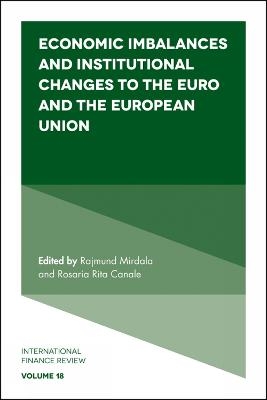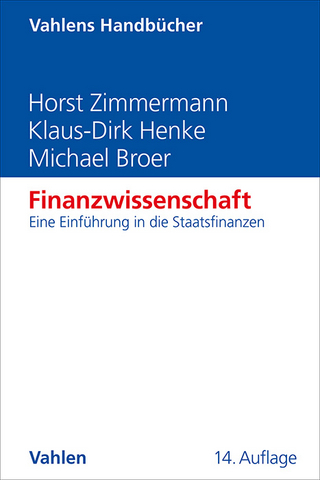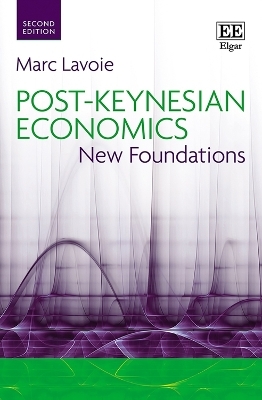
Economic Imbalances and Institutional Changes to the Euro and the European Union
Emerald Publishing Limited (Verlag)
978-1-78714-510-8 (ISBN)
This book offers a critical
perspective from which to observe evolution of the Euro Area and the European
Union in these times of growing economic and political conflict. Key
implications of design failures in the Euro Area (i.e. incorrect diagnostics of
the public finance crisis, single monetary policy failure, heterogeneous
macroeconomic environment, asymmetry in macroeconomic policies, obstacles for
policy coordination) and their contribution to the excessive external and
internal economic imbalances will be critically discussed from the economic,
policy and institutional perspectives. This critical insight is used to examine
both institutional asset and economic performance of Europe after the crisis,
moving from the authors’ shared perspective that the crisis revealed the weak
aspects of the whole architecture of the European Union.
The economic crisis revealed the
existence of different forms of imbalances inside the Eurozone and highlighted
the flaws of the institutional architecture of economic policy in Europe. The
greater fragility of some countries in respect to others has triggered a
backward process in which national interests have started to prevail over those
of both the currency area and the entire European Union. In turn, this has
fuelled a progressive decline in confidence in the European institutions and is
creating growing questions of interpretation both in terms of economic theory
and institutional asset. This book focuses on these issues and on the degree of
legitimacy of the European institutions resulting therefrom. It aims to
investigate the nature and validity of the European integration process
emphasizing limits and challenges arising from it.
Rajmund Mirdala is Associate Professor and Head of Department of economics at Faculty of Economics, Technical University of Kosice, Slovak republic. He is author of five books (Fiscal Policy in the European Converging Economies, Exchange Rates in the Central European Countries, Economic Aspects of Capital Flows Liberalization in the European Transition Economies (co-author), Monetary Rules and Their Importance in the Context of Monetary Union and Economic Crisis (co-author), The Euro Area and the Economic Crisis (co-author)). He has published 30+ articles in foreign scientific journals, 10+ articles in domestic scientific and professional journals, 40+ articles in domestic and foreign conferences. He is principal investigator in 3 projects from national grant schemes, deputy principal investigator in 3 projects from national grant schemes and researcher in 8 domestic and foreign projects. He is a member of 17 editorial boards of foreign scientific journals and reviewer for 26 domestic and foreign scientific journals (8 listed in WoS - Current Contents). His research covers following areas: Macroeconomic and Microeconomic Theory, Monetary Policy, Monetary Integration, International Financial Integration, Exchange Rates, Fiscal Policy, International Capital Flows, Transition Economies, Global Imbalances.Rosaria Rita Canale Ph.d (Naples “Federico II” Univ.) is Associate Professor of Economic Policy at the University of Naples “Parthenope” Her research interest include fiscal and monetary policy, International economics and history of economic thought. She wrote many articles on national and international refereed journals the great part of which indexed on WoS and Scopus. She collaborates with national and international journals as referee. Some of her recent publications are: Structural Public Balance Adjustment and Relative Poverty in the Eurozone Countries: An Empirical Investigation with Liotti G. in “Ekonomický časopis” vol. 64, no. 8, 2016; Trust in Institutions and Income Inequality in the Eurozone: The Role of the Crisis with M. Bonasia, Liotti G. and Spagnolo N. in “Engineering Economics” vol. 27, no. 1, 2016; Capital Flows, Long Term Bond Yields and Fiscal Stance: The Eurozone Policy Trilemma, in “Portuguese Economic Journal”, vol. 14, no. 1, pp. 31-34, 2015; On the Objective of a Sound Public finance in the Eurozone, with Bonasia M. in “Rivista Internazionale di Scienze Sociali”, no. 2, 2016; Structural Adjustment and Enemployment in Eurozone with Liotti G. in “Australian Economic review”, vol. 48, no. 2, 2015; National Disparities and Cyclical Dynamics in Italy (1872-2007). Was Mezzogiorno a Sheltered Economy?, with O. Napolitano in “International Review of Applied Economics”, vol. 23, no. 3, 2015, Current Account and Fiscal Imbalances in the Eurozone: Siamese Twins in an Asymmetrical Currency Union with Marani U. in “International Economics And Economic Policy”, vol. 12, no. 2, 2014; Structural Public Balance Adjustment Effects on Growth in 25 OECD Countries and Eurozone with Liotti G. and Napolitano O. in “Comparative Economic Studies”, vol. 56, no. 4, 2014; Alternative Strategies for Monetary Policy, in “Review of Political Economy”, no. 3, 2011.
Introduction, Economic Imbalances and Institutional Changes to the Euro and the European Union
The Eurozone Policy Model and the Institutional Consolidation Process in the Long-Run; Mariangela Bonasia and Rosaria Rita Canale In or out of love with Europe? An empirical analysis of the determinants of national political
parties’ orientation towards the European Union; De Simone E, D’Uva M, Gaeta G.L.
Development-related Problems and Asymmetries in the Eurozone: The Challenge of the “Strategic” Approach; Nikolaos Karagiannis & Edward K. Zajicek
Rules, Imbalances and Growth in the Eurozone; Daniele Schilirò
Back to national currencies? Monetary integration in an asymmetrical currency area; Sergio Rossi
From anti-growth bias to quantitative easing: the ECB’s belated conversion; Joerg Bibow
Quantitative Easing in the Eurozone; Marta Orviska and John Hudson
Updating the Evidence on Risk-Sharing through the Cross-Ownership of Assets in the Euro-Area; Pasquale Foresti and Oreste Napolitano
Financial Integration at Times of Crisis and Recovery; Jan Babecký, Luboš Komárek and Zlatuše Komárková
EU-Banking Union: Expectations, Differences and Criticism; Dragan Momirović, Marko Janković, Maja Ranđelović
Competitiveness and Macroeconomic Imbalances in Eurozone Countries; Collin Constantine
Current Accounts and Competitiveness Issues in the North and South of the Euro Area; Rajmund Mirdala, Júlia Ďurčová
Is there a debt-overhang problem in the European Union?; Ines Kersan-Skabic
Are they all the same? Banking and financial crises in debt-ridden Euroarea countries; Tiago Cardao-Pito
The Recent Experiences of Capital Flows and Fiscal Imbalances since the Creation of the Eurozone; Yaya Sissokoa and Brian W. Sloboda
Intra-European Union Imbalances and Cyclical Position: Does Monetary Policy Matter?; Jean-Pierre Allegret and Audrey Sallenave
Is there convergence or divergence in the international competitiveness of the Eurozone countries?; Roberto J. Santillán-Salgado and Araceli Ortega-Díaz
Sovereign Debt Crisis: Euro-Reality: Reality.; Julius Horvath and Alfredo Hernandez
| Erscheinungsdatum | 21.08.2017 |
|---|---|
| Reihe/Serie | International Finance Review |
| Verlagsort | Bingley |
| Sprache | englisch |
| Maße | 152 x 229 mm |
| Themenwelt | Wirtschaft ► Volkswirtschaftslehre ► Finanzwissenschaft |
| Wirtschaft ► Volkswirtschaftslehre ► Makroökonomie | |
| ISBN-10 | 1-78714-510-7 / 1787145107 |
| ISBN-13 | 978-1-78714-510-8 / 9781787145108 |
| Zustand | Neuware |
| Haben Sie eine Frage zum Produkt? |
aus dem Bereich


